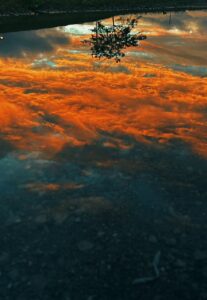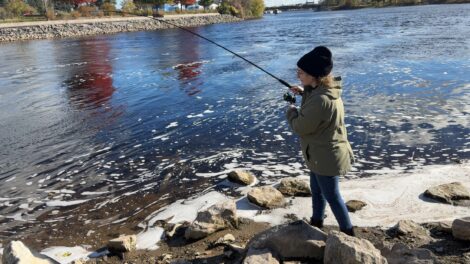DNR urges caution as Michigan sees uptick in fires

News Photo by Julie Riddle A firefighter cools off with a drink as fellow firefighters fill a bag with water to be sprayed on a grass fire in Alcona County on Monday.
ALPENA — Michigan is a tinderbox this spring, officials say.
Since Friday, the Michigan Department of Natural Resources responded to at least 40 fires in the state, according to Don Klingler, DNR resource protection manager for the lower peninsula.
A dry winter and recent sunny skies — pleasant for many residents — have kept DNR and other firefighters busy as dead grassses and spring breezes led to a spate of recent fires around the state.
Fires were reported in all Northeast Michigan counties on Monday, the day a fast-moving grass fire burned 86 acres in Alcona County.
Possibly started by a lidless burn barrel, according to a DNR official, the Monday afternoon fire swept across wild grasses and into a tangle of trees near Black River Road.

News File Photo A firefighter walks across a burned field after fighting a grass fire in Alcona County in this March 2021 News archive photo.
Its flames sometimes taller than a house, the fire jumped a drainage ditch and the Black River, according to Roger MacNeill, forest fire officer out of the Lincoln DNR office, who was at the fire.
“When you have 20-foot flame lengths and debris flying in the air, it just flies over the river and lands on the ground and starts it on fire,” MacNeill said.
Firefighters from the DNR and local townships battled the fire until late Monday night, using controlled burns to build a perimeter around the fire and digging fire lines through marshy land with a bulldozer outfitted for offroading.
A DNR spotter plane buzzed over the scene, reporting the fire’s movement and new small blazes sparked by debris carried in a strong wind.
The minimal snowpack of a winter of record-setting warm temperatures wasn’t enough to flatten the tall grasses of Northeast Michigan’s rural open spaces. Upright grasses burn fast and erratic, especially coupled with strong winds like those seen on Monday, MacNeill said.

News File Photo A firefighting bulldozer rumbles across burned land at the scene of a grass fire in Alcona County in this March 2021 News archive photo.
Grass fires have been rampant in Michigan this spring, with about 20 burning at once on Monday alone — including a fire that burned 600 acres in Manistee — according to MacNeill.
Even in an average year, fires are frequent in spring, when dead grass and woody material blown down by the winter dries in sunshine and becomes the perfect tinder for a blaze.
This year, with little winter precipitation, firefighters are reaching for large-fire tactics they normally don’t use for another six weeks, MacNeill said.
Cities and towns aren’t immune from grass fires, despite their lack of wide-open spaces — anywhere there’s brown grass, there is a chance of fire, Klingler said.
This year’s early grass fire season will lead to a forest fire season in mid-April as jack pines and other conifers pump water into new growth, leaving old needles to dry out and become flammable.

News File Photo A firefighter heads across burned land toward a grass fire in Alcona County in this March 2021 News archive photo.
In drought conditions, fire can smolder underground, burning through the root system until it finds an opening and can “pop up and go,” Klinger said.
The number-one cause of grass and forest fires is debris-burning, according to Klingler.
Despite a dry spring, Klingler urges residents to get outdoors.
“Just be careful,” Klingler said.
As of Tuesday, open debris burning is not permitted anywhere within Northeast Michigan, according to the online DNR burn permit map.
- News Photo by Julie Riddle A firefighter cools off with a drink as fellow firefighters fill a bag with water to be sprayed on a grass fire in Alcona County on Monday.
- News File Photo A firefighter walks across a burned field after fighting a grass fire in Alcona County in this March 2021 News archive photo.
- News File Photo A firefighting bulldozer rumbles across burned land at the scene of a grass fire in Alcona County in this March 2021 News archive photo.
- News File Photo A firefighter heads across burned land toward a grass fire in Alcona County in this March 2021 News archive photo.
- News Photo by Julie Riddle Legs caked with mud, a firefighter cools down after battling a grass fire in Alcona County on Monday.

News Photo by Julie Riddle Legs caked with mud, a firefighter cools down after battling a grass fire in Alcona County on Monday.







